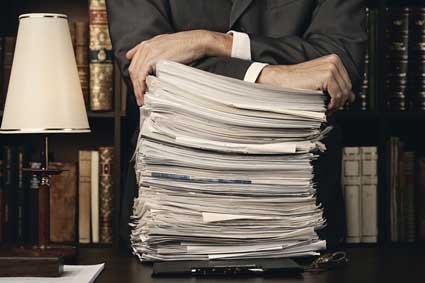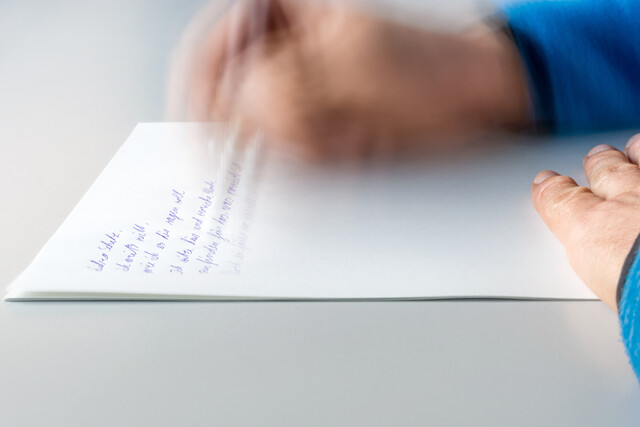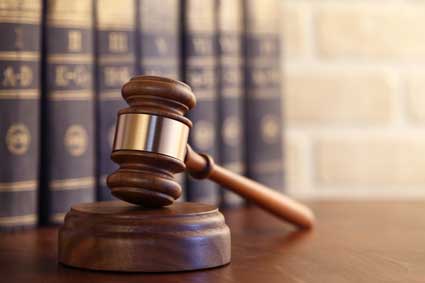When transcribing these documents, pay close attention to legal terms used and any cases cited. Check for proper spelling of terms in your law dictionary and make sure all proper names are accurate. Most documents will be sent certified mail, with a return receipt requested. Always include a cover letter when sending any of these documents to the court. Cover letters usually are not required when copying documents to the opposition, client, and other parties; a copy of the cover letter sent to the court usually is sufficient.
There are often deadlines for many of these documents, so make sure you do not hold them on your desk or delay in sending them out. If you must miss a day of work and a document with a deadline needs to be sent out, be sure to alert someone in the office of that fact so that they can prepare and send it.
When sending such documents, be sure to prepare the required number of copies that need to be sent to the court in question and to send copies to the opposing/interested parties and the client; do not forget a copy for the file. Your attorney and his or her client also will be on the receiving end of any or all of these documents; copies must be made and counter documents filed when receiving them as well. Study the definitions well and be sure you understand the purpose of each document; you might very well be asked during a job interview.
A brief is a written statement prepared by a lawyer and submitted to the court for the following reasons:
-
- to outline the pertinent facts of the case;
- to present the questions of law to be decided;
- to present the position of the lawyer's client as to those questions;
- to list the legal arguments and authorities, such as statutes and appellate court decisions, which support the client's position.
There are four main types of briefs, and you should be aware of each:
Amicus brief: a brief submitted by an amicus curiae. It may also be referred to as a brief amicus curiae. (Amicus curiae is a "friend of the court.") See glossary of terms for a complete definition of this term.
Appellate brief: a brief submitted when the case is on appeal.
Reply brief: a brief that responds to the arguments previously raised in an opponent's brief.
Interrogatories are a form of discovery, or compulsory release, by the opposing party involving the submission of written questions to the other party. These are sent to clarify specific points pertaining to the case that are unclear. Interrogatories are filed with the court and have a deadline placed upon the other party for answering. As with briefs, be sure to make the required number of copies and to send copies to the required parties. Interrogatories are typed with the question first and ample hard returns beneath so as to provide space for answers to each question to be entered. They often are answered in a separate document; however, the procedure is always to leave space after each question put forth by the attorney.
Affidavits are voluntary and written statements of fact that are signed and the truth of their content affirmed or sworn to by the declarant before a notary public or another officer authorized to administer oaths. There are usually one or more notary publics in any law office who will apply their seal when required. See Lesson 13 to learn how to become a notary public.
An appeal is the process of seeking to obtain a review and reversal by a higher court of a lower court's decision. Appeals are filed when the ruling is considered unsatisfactory or in error and must provide specific proof of error or exact reasons why the original ruling should be reviewed and/or reversed. The higher court may or may not agree to review a previous decision, or it may agree to review the appeal but ultimately rule with the prior court's decision; therefore, an appeal is not a guarantee of reversal or review.
A response to a pleading, discovery request, or other procedural step taken by any attorney involved in the case. Answers also are pleadings that are a defendant's response to a plaintiff's complaint. Pleadings deny, admit, or address each allegation in a complaint and may also set forth the defendant's affirmative defenses and counterclaims. An answer may also be referred to as a "reply."
A complaint is an initial pleading of a plaintiff in a civil action that identifies the three following points:
A. the court's jurisdiction;
B. the alleged facts that entitle the plaintiff to relief;
C. the relief sought by the plaintiff.
A deed is a written conveyance of an interest in any real property; it is also the act of granting a deed in property to another. Deeds are used to transfer ownership from one party to another, as in the sale of a house. There are two major types of deed that you will encounter as a legal secretary:
1. Quitclaim deed: a deed conveying the grantor's interest in real property, as is, including any defects in title and with no warranty that title is valid.
2. Warranty deed: a deed that contains one or more warranties, such as the validity of the grantor's title, the recipient's right of "quiet enjoyment" of the property, and the right to resell it free of any encumbrances, as opposed to a quitclaim deed.
The patent of invention is a right or authority granted by the federal government and the document granting that right or authority. It proves exclusive right to make, use, or sell an invention granted to the inventor of a unique device or process for a specified period of time, usually 20 years. Patent applications must be filed before these rights are approved and granted.
Pleadings are formal, written declarations in legal form of logical statements setting forth the facts of the plaintiff's allegations, the defendant's responses, and/or the reasons why each party believes that it is in the right.
Subpoenas are issued at the request of one of the parties to a lawsuit ordering a witness to appear and bring relevant documents to a hearing. These may be sent to secure a person's attendance and testimony at trial or other proceedings, such as a deposition. Subpoenas are issued by the court but usually requested by attorneys.
A will is essentially a document spelling out what is to be done with the belongings of a person, referred to as the testator, after he or she has died. The document has no force while the person is alive and may be altered or revoked at any time, but it becomes applicable to the conditions of the estate at the time of the testator's death. A will is effective only at time of death. There are three types you will encounter most often as a legal secretary:
1. Joint and mutual will. One will executed by two or more persons with reciprocating provisions of consideration of each to the other. Wills of this type usually are filled out by married couples and life partners.
2. Joint will. A single will signed by two or more persons but not necessarily reciprocating or mutual. This is often the case when certain possessions are willed to a third party by one or more of the signers.
3. Last will and testament. Phrase commonly used to refer to the latest, or most recent, instrument directing the disposition of the personal property of the signer(s).
You undoubtedly will run across other legal documents as you proceed in your career as a legal secretary, however, the above mentioned are those you will run across most often. Your attorney will provide names of opposing parties and the name of the court that documents will need to be filed with. As mentioned in the introduction, you will be charged with transcribing or typing up said documents, preparing the correct number of copies, and sending them to interested parties via certified or regular mail. Be sure to have a clear understanding of each document's purpose before applying for a position as a legal secretary. Take the review below to test your knowledge.
Legal Document Preparation
In addition to typing documents, preparing them for sending is a large part of a legal secretary's position. Depending on the type of document, once it has passed the final draft stage and has been printed and signed, you will make collated copies and bind, package, and send them to the appropriate parties. You must include all marked exhibits to accompany the document in their proper order, as directed by your attorney. You must be organized from the outset to ensure that everything is packaged as it should be and all parties receive their copies.
Most medium-sized to large firms have a copy room that provides multiple copy machines, along with fax, stamp, and binding machines and various office supplies needed for sending out large amounts of paperwork. Even small firms will have a copy machine with a collation feature. Because most legal documents must be sent to many parties and require several copies for the court, it is necessary to use the collation feature of the copy machine. This feature allows you to input the number of copies of any given document, and the machine will sort the pages into individual sets or bundles. Many copiers also will staple the sets as well; just be sure to initialize the staple feature before you begin copying.
Many law office documents require binding before being sent. This simply means that the document has thick paper covers attached to front and back and is bound with a plastic binder at the left side. Many large offices source this job out; however, there are occasions when time is of the essence and the documents must be bound in-house. Medium-sized and smaller firms will nearly always bind in-house. A binding machine is rather simple to operate. If you are not familiar with its operation, ask co-workers if you may watch when they bind a document. Covers will vary from office to office. Often you will have to create the typed front covers on your computer and then print them out on your printer; or, if there is a large number of covers that need to be made, perhaps 10 or more, print out one and copy the rest via the copy machine. The back cover is blank. Covers are often heavyweight, blue bond paper, but they may be of some other material or color.
The essentials of binding are as follows:
1. Make the required number of copies of the document to be bound.
2. Create the front and back covers as per office procedure.
3. Make the required holes along the left length of the document, including the covers, with the provided hole puncher on the binding machine. Be sure to set the holes properly so that the text is readable when the "book" is opened and not too far to the left edge; a quarter-inch from the edge is the standard measure.
4. Insert the male and female plastic strips through the holes and snap them into place.
5. Place the length of the plastic strip and document into the binder and press the lever down firmly until set, usually a few seconds to a minute.
6. Set bound copy aside.
7. Complete for all copies.
The binder will heat the plastic strips so that a permanent bond is formed. This will keep the papers from coming loose. If you are nervous about doing this for the first time, gather a few pieces of printer paper and do a trial run first. After you have bound a few copies, you will find this procedure to be simple and will get through it quickly.
Packaging mail correctly is a job within itself. Be sure that you have included all required copies of any documents, a check to the court if needed, a self-addressed stamped envelope (SASE) for the court to return copies of papers marked "filed," and any other required documentation.
Mail will go out in one of four ways. regular, certified with return receipt requested (RRR), or overnight mail; or via courier:
Regular mail: This service is used for general documents, non-urgent letters, bills, and any documents your attorney essentially deems "no rush." The procedure is to make appropriate copies, address envelopes, package documents and any other items inside the envelopes, stamp them, and give them to the receptionist or postal carrier. Often multiple, unassociated items will be set aside and mailed together at one time, rather than packaging and sending them one at a time. For multiple items being sent, it is advisable to use an in-house stamp machine if one is available.
Certified mail, RRR: Any items that are considered of importance are sent certified mail with Return Receipt Requested. They do not get to the addressee any faster than regular mail; however, there will be a record of sending and receiving. The procedure for packaging and sending is the same as for regular mail, but you must fill out the receipts that are attached to the envelope before sending and attach the customer receipt to the client file copy.
Overnight: Overnight mail and packages are handled by many companies; the top companies you will encounter are United Parcel Services (UPS), Federal Express (FedEx), and USPS (United States Postal Service). Each of these companies is separate and has no affiliation with the others. USPS is a government entity that offers overnight, express, and priority mail delivery. Your office may use one or more of these companies. Whatever carrier(s) your office uses will provide envelopes to the office for convenience. Most secretaries keep a stack handy in their office or cubby at all times. To send overnight, make required copies and package in the envelope provided by UPS, USPS, FedEx, or whatever carrier your office uses. Be sure to provide the correct sending information on the outside label. Give this package personally to the carrier, who usually picks up once per day; or to the receptionist to give to the carrier; or place items in the provided pickup box. Most major overnight carriers offer drop boxes inside or outside offices.
Courier: Courier services must be called when needed. Provide the correct sending addresses and all pertinent information to the courier, as well as your contact information in case there are questions. Courier services most often are used with urgent documents, particularly when there are many copies that need to be sent. You will be advised if your attorney needs items sent via courier.
Treat each and every document that is being packaged and sent as if it were of vital importance, pay close attention to what you are doing, and double check everything before letting it leave your office. If you do, you will find errors to be minimal. If you discover that you have forgotten someone or something after the document has been sent, quickly rectify the situation. If you forgot to send a copy to any party, make a copy from the file and send it out as soon as possible. If you forgot to send a check or any other item to the court, put the item in the mail and call the court to make the clerks aware of your error and assure them that the missing item will arrive shortly. If time is of the essence, send items overnight or via courier. Most importantly, try to avoid errors, but do not panic if you slip up on occasion. Mistakes are bound to happen once in a while. It is more important that you catch any mistakes and correct them quickly and without fanfare.
























